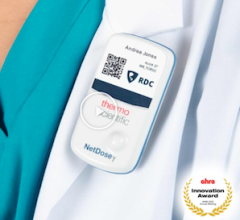
Innovation is trending toward improved efficiency — but not at the expense of patient safety, according to Michael Perez de Utrera, diagnostic imaging manager of the seven Leon Medical Centers in Miami, Fla. (Six of these include CT; the seventh focuses on women’s health and includes mammography, MRI and bone densitometry.)
Efficiency is important, de Utrera told Imaging Technology News, after presenting at the AHRA 2019 exhibitor symposium titled “Utilizing Technology in a Modern Healthcare Facility — Emerging Trends,” because “reimbursement rates continue to lessen — but definitely patient safety always comes first.”
Patient centric imaging at Leon Medical Centers is being pursued in the context of operational efficiency, de Utrera said during the July 24 symposium. This is evidenced by the move away from paper medical records to electronic records and health records, and the continuing pursuit of efficiency metrics in data analytics and the growth of smart ancillary devices. Integrating these smart devices with EMRs “definitely improves efficiency,” he said.
Role of the Electronic Medical Record
EMR systems form the cornerstone of this trend toward the increasing use of smart devices, which feed the information they gather to EMRs. During his AHRA presentation, de Utrera discussed a slide quoting HealthITAnalystics.com as predicting health care data will increase at a compound annual growth rate of 36 percent through 2025 — faster than the CAGR of data in manufacturing, financial services or media. This rapid pace of data growth can be leveraged to increase efficiency, said de Utrera, who singled out smart devices for their potential to positively impact both patient care and business decisions. One of these is a group of “smart inject solutions” exemplified by NEXO software, which is used across the Leon Medical Centers to help manage contrast and track patient radiation exposure.
Where NEXO Software Fits
Staff at the Leon centers use the software to promote operational efficiency. For example, NEXO allows remote access to power injectors, which allows the staff to manage protocols and measure efficiency through cost-based metrics.
Patient care can be monitored as in the case of saline advance and contrast media injections as part of MRI protocols. Risk can be assessed during contrast administration by evaluating extravasations that may occur during CT exams.
Through innovation in imaging technology, patient data are driving decisions in imaging and health care at the centers, he said. Smart Inject solutions display and document CT and MRI contrast administrations, said de Utrera, noting in one injector display (shown to the audience in a slide) the appearance of a pressure spike that may indicate an extravasation.
And NEXO is not constrained to just contrast data. Using its dashboard function, staff can identify, for example, patients who are at the greatest risk of accumulating too much radiation. (The 10 patients who have received the most radiation over the last 90 days, for example, might be identified.) The dashboard can also be programmed to display the most commonly performed examinations, along with average CTDI Vol (the average the total amount of radiation applied during CT exams).
Data Tailoring
Dose averages can be listed by device in customized reports. Similarly, results can be split and quantified, as in the utilization of equipment, staff productivity, even compliance of a standard, for example, ACR dose thresholds, de Utrera said.
A scatter graph of dots can be presented visually to depict exam performance. Clicking on a specific dot provides the details of a specific exam, revealing protocols, patient positioning or the doses of radiation administered to that patient. Alerts can be sent to the radiation safety officer, for example, chief radiologist, or imaging administrator if dose thresholds are crossed.
“Alerts provide the opportunity to improve,” he said. “They can bring new cases to your attention and give you the chance to discuss them with staff.”
In these ways, de Utrera said during his talk, power injectors can be accessed and monitored remotely; regulatory compliance can be ensured; staff can enhance their clinical skills — and patient care can be improved.
Greg Freiherr is a contributing editor to Imaging Technology News. Over the past three decades, he has served as business and technology editor for publications in medical imaging, as well as consulted for vendors, professional organizations, academia, and financial institutions.
Editor’s note: This article is the ninth piece in a content series by Greg Freiherr covering The Association for Medical Imaging Management (AHRA) annual meeting in Denver. The first article, How Standardizing Protocols Can Save Time and Money, can be found here. The second article, How Artificial Intelligence Might Impact Radiology, can be found here. The third article, How To Manage Risk in the MR Suite, can be found here. The fourth article, DR Advances Promote Imaging of Whole Spine, can be found here. The fifth article, Payment Models Seek Traction in Transition from Volume, can be found here. The sixth article, Liars in Radiology Beware! can be found here. The seventh article, When Bad Things Happen to Imaging Departments, can be found here. The eighth article, Imaging Market in U.S. Could Rise In Coming Years, can be found here.
Related content:
When Bad Things Happen to Imaging Departments
FFR-CT: Is It Radiology or Cardiology?
Payment Models Seek Traction in Transition from Volume
DR Advances Promote Imaging of Whole Spine
How Standardizing Protocols Can Save Time and Money
How Artificial Intelligence Might Impact Radiology
Across the Chasm Aim 5: Health Care Must Be Efficient
5 Ways How Big Data is Boosting the Efficiency of Healthcare Services
Health Care Efficiency: Measuring the Cost Associated With Quality


 December 01, 2025
December 01, 2025 









